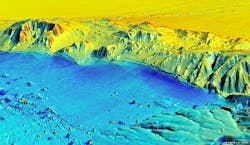Navy chooses Navmar to apply laser radar to persistent-surveillance sensor payloads
JOINT BASE MCGUIRE-DIX-LAKEHURST, N.J., 23 Aug. 2012. Surveillance sensors designers at Navmar Applied Sciences Corp. in Warminster, Pa., will use laser radar (LADAR) technology in persistent surveillance sensor packages for use at U.S. forward-operating bases in Afghanistan under terms of a $20 million contract awarded this month.
Navmar won a Phase III B Small Business Innovation Research (SBIR) contract to build 127 Persistent Ground Surveillance Systems (PGSS) Gondolas Gen 3.2 sensor systems and install them on aerostat gondolas under terms of the contract from the U.S. Naval Air Warfare Center (NAWC) Aircraft Division at Joint Base McGuire-Dix-Lakehurst, N.J.
The sensors are part of the U.S. Army Persistent Ground Surveillance Systems (PGSS) program to mount a broad variety of persistent-surveillance sensors on tethered helium-filled blimps that float as high as 3,000 feet off the ground for wide-area surveillance.
The Navmar SBIR contract pertains to laser radar identification demonstration and air deployable multi-parameter environmental probe technologies.
Navmar won NAWC contracts last summer for advanced research in unmanned aerial vehicles (UAVs) and persistent-surveillance UAV sensor payloads for a UAV called Helios for military use in Afghanistan.
In 2010 Navmar won a $9.2 million NAWC contract to demonstrate laser direction and ranging (LADAR) capability in an operational U.S. Navy squadron to help identify potentially hostile aircraft at ranges farther than 50 nautical miles. Navmar also does work in oceanographic sensors.
On the current contract, Navmar will do the work in Jessup, Md., and should be finished by August 2013.
For more information contact Navmar online at www.nasc.com, or NAWC at www.navair.navy.mil/nawcad.
Follow Military & Aerospace Electronics and Avionics Intelligence news updates on Twitter

